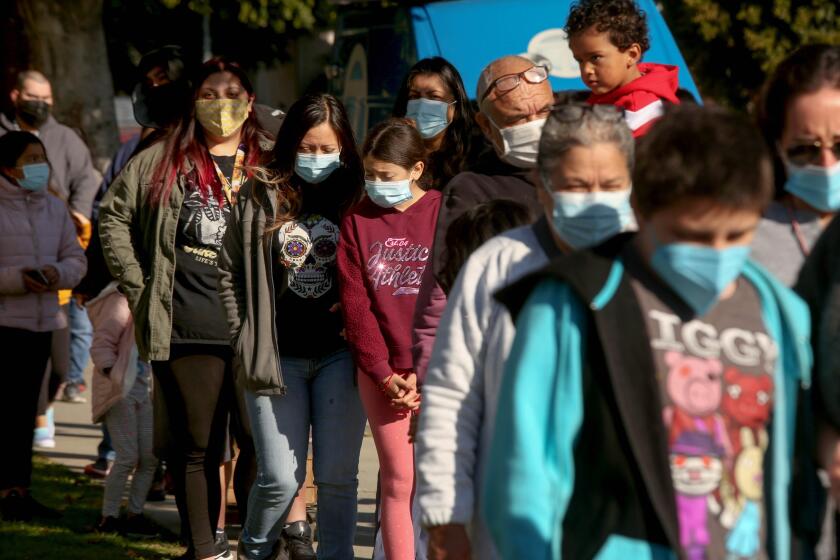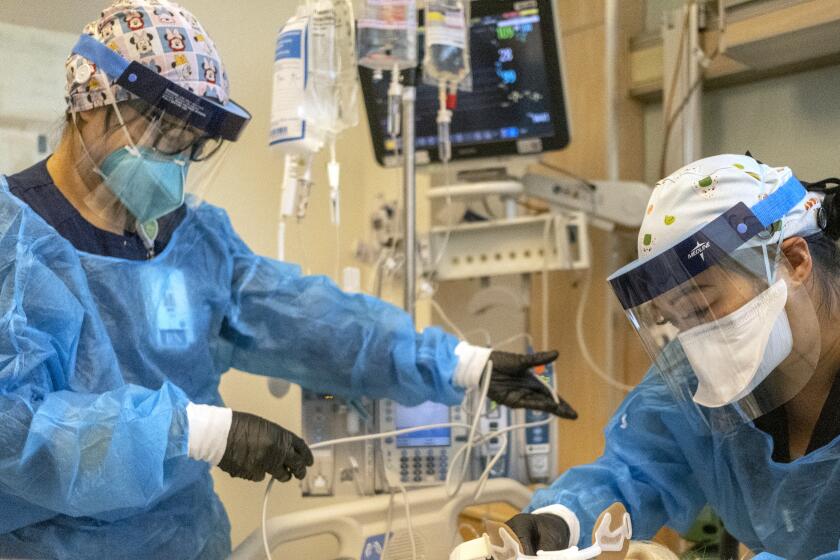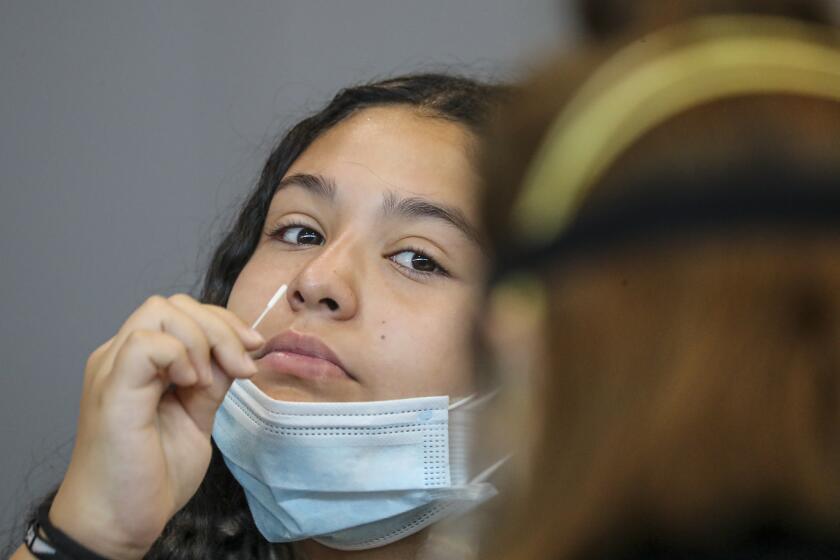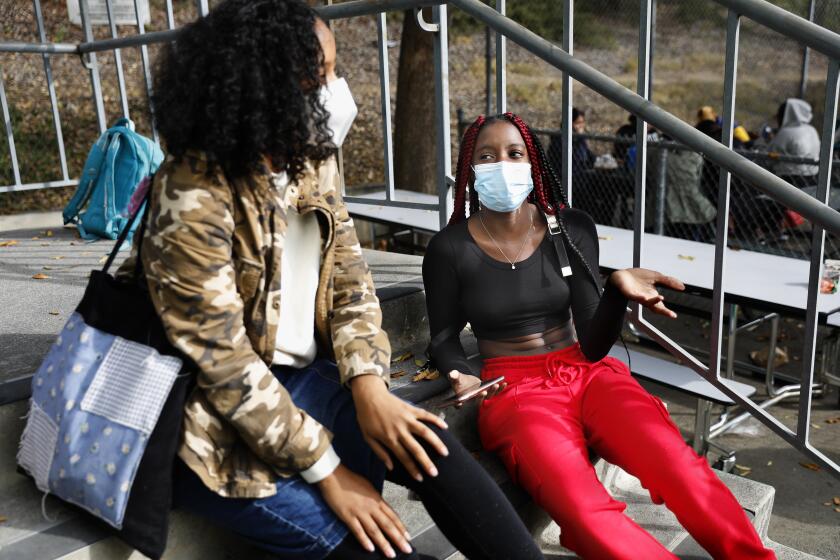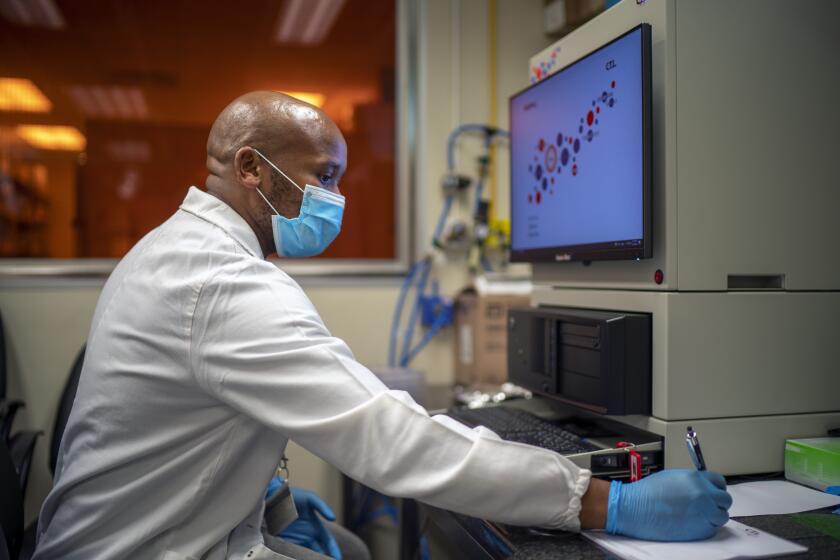Omicron wave is inundating California. How to protect yourself and others

- Share via
With the Omicron variant of the coronavirus spreading rapidly throughout California, officials are urging Californians to do their part to help ease the surge.
“The next several weeks are absolutely critical,” said Dr. Grant Colfax, San Francisco’s director of health, in a statement Tuesday. “It is within our power to limit the damage of this latest surge, but we need everybody’s help.”
Here are some things you can do to stay safe:
Use better masks
To reduce coronavirus spread, health officials are urging people to use masks that are medical grade, such as surgical (or blue), or N95, KN95 or KF94 masks. Wearing an old, loose, cloth mask alone is less effective. Placing a cloth mask on top of a surgical one can be more effective than a surgical mask alone as it tightens the fit.
Health officials say it’s important to improve the fit of face masks and their filtration, going beyond old, loose, cloth face coverings.
The California Department of Public Health says that good masks have the following properties:
■ Two layers of tightly woven cotton with a third layer of nonwoven fabric. The third layer could be an inserted mask filter or a synthetic fabric, such as polypropylene.
■ Nose wires to reduce gaps around the nose.
■ Adjustable ear loops or straps that go around the head to reduce gaps around the face.
Last month, California ordered a statewide mask mandate for indoor public spaces.
Roughly two-thirds of patients who have tested positive at the four hospitals run by the L.A. County Department of Health Services were admitted for something other than the coronavirus.
Don’t go to the ER unless necessary
Officials on Monday urged people to avoid going to an emergency room unless they have a true medical emergency.
“While we continue to experience the surge in cases, [the Department of] Public Health is reminding residents to avoid visiting the emergency room unless they need emergency medical care. Residents should not be visiting the emergency department solely to get a COVID test or for minor complaints that could be resolved through their primary care physician,” the Los Angeles County Department of Health Services said in a statement.
“Emergency room visits should be reserved for those patients who are feeling severely ill — for example, those who are short of breath — or who have serious concerns about their health and who require immediate emergency care.”
U.S. courts in L.A. County and six other counties in California halt jury trials for at least three weeks to prevent spread of COVID-19.
You can go here — remotely
Ventura County officials announced the region would close its buildings to the public as a precaution for three weeks starting Wednesday. Services will still be offered online and by appointment.
“More people are infectious and spreading the virus indoors,” Ventura Public Health Officer Dr. Robert Levin said in a statement. “Taking these steps — limiting close contacts, wearing a mask indoors to prevent getting infected and infecting others, isolating when symptomatic, testing and getting vaccinated — can reduce the likelihood of severe COVID affecting you, your family and community.”
Starting Monday, Newport Beach also temporarily closed its City Hall and community centers. In a statement, officials said that “all city services will continue, although some will be conducted only through virtual and drop-off” methods and that they anticipate the new protocols will be in place through mid-January.
On Tuesday, the Los Angels City Council announced it will return to virtual meetings during January as officials assess the latest COVID-19 surge. Meetings were held virtually from March 2020 through June 15, 2021, when the City Council resumed in-person meetings twice a week, although members of the public were still allowed to participate only virtually.
Most UC campuses started the winter quarter Monday with two weeks of remote classes — a decision announced days before Christmas as Omicron cases prompted new warnings for caution from health experts and public officials.
As school districts resumed classes Monday, many did so without having received a single test from the state.
What schools require
The Los Angeles school district has ordered coronavirus tests for all students and staff before they return from winter break next week as a new period of high anxiety takes hold among parents and educators.
The drill in the nation’s second-largest school system will mean anyone who intends to step on a campus next week to work or learn will have to show proof of a negative coronavirus test. The announcement was made hours after a hastily called special school board meeting Monday morning.
Employees not already on duty this week would receive two hours’ pay to get a test this week. If they wait till Monday — when they are back on the clock after winter break — they will receive any time off needed to be tested but no extra pay. School employees return to work Jan. 10. The students return Jan. 11.
The baseline testing would supplement ongoing required weekly testing of all students and staff — about 500,000 swabs per week. Families may provide a PCR test or an antigen test — either from a district testing site or from elsewhere. They also may use at-home tests. But officials are asking families to have results uploaded into the district’s Daily Pass system by Sunday, Jan. 9.
The district’s plan won immediate support from unions representing clerical workers, teachers and administrators.
What’s being done to keep kids safe as schools reopen during Omicron surge
Get teens boosted
The federal government has begun the process to make younger teenagers eligible for booster shots. The U.S. Food and Drug Administration on Monday authorized boosters for 12- to 15-year-olds, but the U.S. Centers for Disease Control and Prevention must make a recommendation before the shots are made available for that age group.
“The data shows there are no new safety concerns following a booster in this population,” the FDA said in a statement. The agency said that no new cases of myocarditis, an inflammation in the heart, have been reported.
The FDA also cut from six months to five months the authorized amount of time between the second dose of the Pfizer-BioNTech primary vaccination series and a booster shot, for anyone age 12 and older.
In addition, the agency authorized certain children ages 5 to 11 with weakened immune systems to receive a third dose of a COVID-19 vaccine.
Here are some of the questions researchers are still trying to answer about the latest version of the virus that causes COVID-19.
More tips
Here are some safety tips from the San Francisco Department of Public Health:
- Have everyone ages 5 and older get their COVID-19 vaccination and booster if eligible.
- Anyone who develops symptoms of COVID-19 should isolate themselves and get tested as soon as possible.
- Get tested before travel, upon return and again three to five days later.
- Take advantage of quick and easy at-home test kits available in pharmacies and stores.
- Outside gatherings are safer than indoor gatherings. Limit the number and size of indoor gatherings.
- Take all precautions, including vaccinations, boosters and testing when gathering with others without masks — especially with elderly or immunocompromised individuals, and anyone who is unvaccinated or not yet boosted.
- Wear a well-fitted mask indoors and in crowded settings. To best protect yourself, wear an N95 or double mask with a cloth mask over a surgical mask to improve the seal. If possible, avoid wearing only a cloth mask during this surge.
- Unvaccinated adults should avoid travel and gatherings outside their household.
- Wash hands or use hand sanitizer often.
- Layer your defenses, and reduce your household’s risk exposure during periods of high transmission, like the current Omicron surge.
Resources
- Is it safe to workout at an indoor gym?
- How about indoor dining?
- What should I do if I test positive?
- Ideas for upgrading your mask
- Tips for flying
More to Read
Sign up for Essential California
The most important California stories and recommendations in your inbox every morning.
You may occasionally receive promotional content from the Los Angeles Times.
